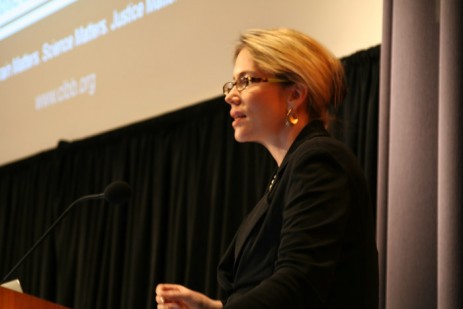
Amanda Pustilnik speaking at CLBB’s April 2013 “Models of the Mind” event at Harvard Medical School. Pustilnik will be the 2014-2015 Senior Fellow in CLBB’s joint venture with Harvard Law School’s Petrie-Flom Center for Health Law, Biotechnology and Bioethics.
ABSTRACT: Legal statuses, prohibitions, and protections often turn on the presence and degree of physical pain. In legal domains ranging from tort to torture, pain and its degree do important definitional work by delimiting boundaries of lawfulness and of entitlements. The omnipresence of pain in law suggests that the law embodies an intuition about the ontological primacy of pain. Yet, for all the work done by pain as a term in legal texts and practice, it has had a confounding lack of external verifiability. As with other subjective states, we have been able to impute pain’s presence but have not been able to observe it directly.
Now, pain is about to become visible. Neuroimaging is rendering pain, and potentially myriad other subjective states, at least partly ascertainable and quantifiable. How will – and how should – pain neuroimaging influence areas of legal doctrine that turn on presence and degree of physical pain?
This emerging ability to ascertain and quantify subjective states is prompting a “hedonic” or a “subjectivist” turn in legal scholarship, which has sparked a vigorous debate among scholars as to whether, and why, the quantification of subjective states might affect legal theory and practice. Subjectivists argue that neuroimaging will lead to broad changes in legal theory: They contend that much values-talk in law has merely been a necessary but poor substitute for quantitative determinations of subjective states – determinations that will be possible in the law’s “experiential future.”
This Article argues the converse: that pain discourse in law frequently is a heuristic for values. Drawing on the author’s interviews and laboratory visits with pain neuroimaging researchers, this Article first shows the current and in-principle limitations of pain quantification through neuroimaging. It then presents close readings of statutes, case law, and treatises in two sets of case studies to show the heuristic role of pain discourse. The first set of case studies compares definitions of torture in criminal torture-murder and in state torture, while the second explores the role of pain rhetoric in recent Eighth Amendment challenges to execution by lethal injection and legislative restrictions on abortion based on putative fetal pain.

Attempting to solve normatively-freighted legal problems through simple quantification would be profoundly misguided. Instead, the Article proposes a novel theory, the theory of “embodied morality,” to explain why statements about physical pain in law often serve a heuristic function. In describing the relationship between pain and empathy, the Article shows how moral conceptions of rights and duties are necessarily informed by human physicality and constrained by the limits of empathic identification. Pain measurement thus serves as the archetypal example of why it is necessary to understand embodied morality within the law to properly understand if, when, and how to adapt the findings of brain imaging to bodies of legal doctrine. Attempting to resolve values-laden issues with hedonic measurement techniques would be to buy into a measurement fallacy; this in turn would produce policy prescriptions as morally unconvincing as they would be practically infeasible.
Source: Cornell Law Review Vol. 97, Issue 4, August 2012, pp. 801–847. By Amanda C. Pustilnik.



